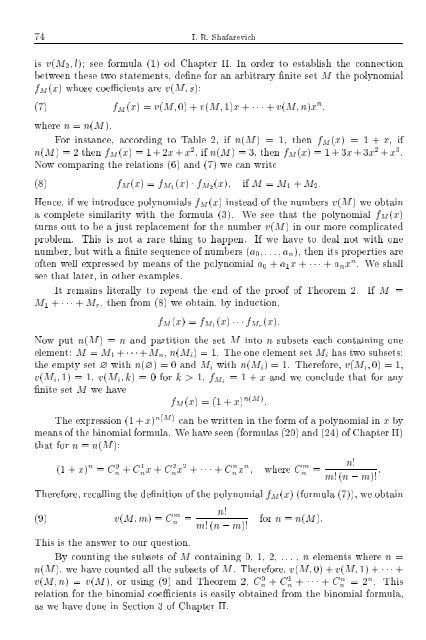SELECTED CHAPTERS FROM ALGEBRA I. R. Shafarevich Preface
SELECTED CHAPTERS FROM ALGEBRA I. R. Shafarevich Preface
SELECTED CHAPTERS FROM ALGEBRA I. R. Shafarevich Preface
Create successful ePaper yourself
Turn your PDF publications into a flip-book with our unique Google optimized e-Paper software.
74 I. R. <strong>Shafarevich</strong>is v(M 2 l) see formula (1) od Chapter II. In order to establish the connectionbetween these two statements, dene for an arbitrary nite set M the polynomialf M (x) whose coecients are v(Ms):(7) f M (x) =v(M0) + v(M1)x + + v(Mn)x n where n = n(M).For instance, according to Table 2, if n(M) = 1, then f M (x) = 1+x, ifn(M) = 2 then f M (x) =1+2x + x 2 ,ifn(M) = 3, then f M (x) =1+3x +3x 2 + x 3 .Now comparing the relations (6) and (7) we can write(8) f M (x) =f M1 (x) f M2 (x) if M = M 1 + M 2 :Hence, if we introduce polynomials f M (x) instead of the numbers v(M) we obtaina complete similarity with the formula (3). We see that the polynomial f M (x)turns out to be a just replacement for the number v(M) in our more complicatedproblem. This is not a rare thing to happen. If we have to deal not with onenumber, but with a nite sequence of numbers (a 0 ...a n ), then its properties areoften well expressed by means of the polynomial a 0 + a 1 x + + a n x n . We shallsee that later, in other examples.It remains literally to repeat the end of the proof of Theorem 2. If M =M 1 + + M r , then from (8) we obtain, by induction,f M (x) =f M1 (x) f Mr (x):Now put n(M) = n and partition the set M into n subsets each containing oneelement: M = M 1 + + M n , n(M i )=1. The one element set M i has two subsets:the empty set ? with n(?) =0andM i with n(M i )=1. Therefore, v(M i 0) = 1,v(M i 1) = 1, v(M i k)=0fork > 1, f Mi =1+x and we conclude that for anynite set M we havef M (x) = (1 + x) n(M) :The expression (1 + x) n(M) can be written in the form of a polynomial in x bymeans of the binomial formula. We have seen (formulas (20) and (24) of Chapter II)that for n = n(M):(1 + x) n = C 0 n + C1 n x + C2 n x2 + + C n n xn where C m n = n!m!(n ; m)! .Therefore, recalling the denition of the polynomial f M (x) (formula (7)), we obtain(9) v(Mm) =C m n =n!m!(n ; m)!for n = n(M):This is the answer to our question.By counting the subsets of M containing 0, 1, 2, . . . , n elements where n =n(M), we have counted all the subsets of M. Therefore, v(M0) + v(M1) + +v(Mn) = v(M), or using (9) and Theorem 2, C 0 + n C1 + + n Cn = n2n . Thisrelation for the binomial coecients is easily obtained from the binomial formula,as we have done in Section 3 of Chapter II.
















